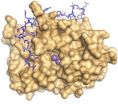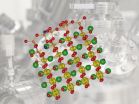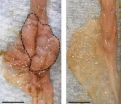(Press-News.org) PROVIDENCE, R.I. [Brown University] — In the Proceedings of the National Academy of Sciences, a team of scientists at Brown University reports a major step forward in determining the specific behavior of the ubiquitous enzyme PP1 implicated in a wide range of diseases including cancer.
PP1, whose role is to enable the passage of molecular messages among cells, is found pretty much everywhere in the body. Its wide range of responsibilities means it is essential to many healthy functions and, when things go wrong, to diseases. But its very versatility has prevented it from being a target for drug development, said Rebecca Page, associate professor of biology at Brown and the paper's corresponding author.
"The amazing thing about PP1 is that no one has wanted to touch it for the most part as a drug target because PP1 is involved in nearly every biological process," Page said. "It's not like you could just target the PP1 active site for, let's say, diabetes because then you are going to affect drug addiction, Alzheimer's disease and all these other diseases at the same time."
In other words, make a medicine to block PP1 in one bodily context and you'd ruin it in all other contexts. Structural biologists such as Page and Brown co-author Wolfgang Peti have therefore been eager to learn what makes PP1 behave in specific ways in specific situations.
The key is the way PP1 binds with more than 200 different regulatory proteins. Scientists know of these proteins and know the sequences of amino acids that compose them, but they don't know their structure or how they actually guide PP1.
"The ability to predict how these PP1 interacting proteins bind PP1 from sequence alone is still missing," Page and her colleagues wrote in PNAS.
Now, through experiments in which her team including lead author Meng Choy combined NMR spectroscopy, X-ray crystallography and techniques in biochemistry, she has learned how PP1 binds to a targeting protein called PNUTS, forming "binding motifs." That knowledge, combined with what she learned in earlier studies about two other targeting proteins — NIPP1 and spinophilin — has allowed her team to predict how PP1 binds with 43 of the 200 regulatory proteins that give it specific behavior.
"What this work in conjunction with two of our previous structures allowed us to do was to define two entirely new motifs," she said. "From that, comparing the sequences with the known proteins that interact with PP1 whose structures we don't have, we were able to predict that 20 percent of them likely interact in a way that is similar to these three proteins."
So by resolving the structure of just three proteins with PP1, Page now has the means to understand the binding of many proteins without having to resolve their structure. Instead she need only know the few motifs and the proteins' sequences.
As for PP1's interactions with the other 80 percent or so of regulatory proteins, those remain a mystery. But Page said the success her team has had in the lab working with PP1 and resolving key motifs makes her optimistic that those interactions can be solved, too.
INFORMATION:
In addition to Page, Choy, and Peti, the paper's other authors are Martina Hieke, Ganesan Senthil Kumar, Greyson Lewis, Kristofer Gonzalez-DeWhitt, Rene Kessler, Benjamin Stein, and Manuel Hessenberger of Brown and Angus Nairn of Yale.
The National Institute of General Medical Sciences (grant R01GM098482) supported the research.
Big stride in understanding PP1, the ubiquitous enzyme
2014-03-03
ELSE PRESS RELEASES FROM THIS DATE:
Mount Sinai study points to new biological mechanisms, treatment paradigm for kidney disease
2014-03-03
New York, NY – Prevention and reversal of chronic kidney disease is an urgent public health need. The disease affects 1 in 10 Americans, is debilitating and deadly, and existing drugs, at best, offer only mild delay in progression to end-stage kidney failure. New research led by Icahn School of Medicine at Mount Sinai investigators has uncovered abnormal molecular signaling pathways from disease initiation to irreversible kidney damage, kidney failure, and death. Results from their preclinical and human research are published online March 3 in the Journal of Clinical Investigation.
"Our ...
Researchers identify 'carbohydrates in a coal mine' for cancer detection
2014-03-03
Researchers at New York University and the University of Texas at Austin have discovered that carbohydrates serve as identifiers for cancer cells. Their findings, which appear in the journal Proceedings of the National Academy of Sciences, show how these molecules may serve as signals for cancer and explain what's going on inside these cells, pointing to new ways in which sugars function as a looking glass into the workings of their underlying structures.
"Carbohydrates can tell us a lot about what's going on inside of a cell, so they are potentially good markers for ...
New discovery solves problem of anti-inflammatory substance
2014-03-03
There have been great expectations regarding the production of a drug to block the enzyme LTA4 hydrolase, which plays a key role in the body's inflammatory response. However, in clinical trials, such molecules have proven to be only moderately effective. Now, researchers at Karolinska Institutet have successfully refined their understanding of why previous substances have been less effective – and in so doing have produced a molecule that gets around the problem. Consequently, there is once again hope of a new anti-inflammatory drug based on the principal of blocking LTA4 ...
Large mammals were the architects in prehistoric ecosystems
2014-03-03
Researchers from Denmark demonstrate in a study that the large grazers and browsers of the past created a mosaic of varied landscapes consisting of closed and semi-closed forests and parkland. The study will be published on Monday 3 March 2014 in the renowned journal PNAS (Proceedings of the National Academy of Sciences of the United States of America).
Dung beetles recount the nature of the past
The biologists behind the new research findings synthesized decades of studies on fossil beetles, focusing on beetles associated with the dung of large animals in the past ...
Electronics based on a 2-D electron gas
2014-03-03
Usually, microelectronic devices are made of silicon or similar semiconductors. Recently, the electronic properties of metal oxides have become quite interesting. These materials are more complex, yet offer a broader range of possibilities to tune their properties. An important breakthrough has now been achieved at the Vienna University of Technology: a two dimensional electron gas was created in strontium titanate. In a thin layer just below the surface electrons can move freely and occupy different quantum states.
Strontium titanate is not only a potential future alternative ...
Gut microbes spur development of bowel cancer
2014-03-03
It is not only genetics that predispose to bowel cancer; microbes living in the gut help drive the development of intestinal tumors, according to new research in mice published in the March issue of The Journal of Experimental Medicine.
Bowel cancer, also called colorectal cancer, results from a series of genetic changes (mutations) that cause healthy cells to become progressively cancerous, first forming early tumors called polyps that can eventually become malignant. Although mutations can occur anywhere in the human intestine, certain types of colorectal cancer tend ...
In academia, men more likely to cooperate with lower-ranked colleagues
2014-03-03
In academic circles at least, women tend to cooperate with same-sex individuals of higher or lower rank less often than men do. So say researchers who report evidence on March 3 in the Cell Press journal Current Biology. The findings are based on a study of the publication records of professors working at 50 North American universities.
"People are often upset to hear evidence of sex differences in behavior," says Joyce Benenson of Harvard University. "But the more we know, the more easily we can promote a fair society."
The findings might seem somewhat counterintuitive. ...
People with sleep apnea may be at higher risk of pneumonia
2014-03-03
People with sleep apnea appear to be at higher risk of pneumonia than people without, according to a study published in CMAJ (Canadian Medical Association Journal).
Sleep apnea is characterized by disrupted sleep, caused when the upper airway becomes obstructed by soft tissue, cutting off oxygen. It has been linked to several types of heart disease and cognitive impairment. People with obstructive sleep apnea are at higher risk of aspiration while sleeping.
To determine whether sleep apnea is linked to the development of pneumonia, Taiwanese researchers followed 34 ...
Calculating cooperation
2014-03-03
It's long been a popular stereotype: Men are hugely competitive, meaning cooperative effort is the exception rather than the norm, while women have a tendency to nurture relationships with others, making them much more likely to cooperate with one another.
A new Harvard study, however, is turning that cliché on its head.
In fact, within academic departments women of different social or professional "ranks" cooperate with each other less well than men do, according to Joyce Benenson, an Associate of Harvard's Human Evolutionary Biology Department and Professor of Psychology ...
Medicare Part D prescription drug coverage saved $1.5 billion a year in first 4 years
2014-03-03
A new study by the Johns Hopkins Bloomberg School of Public Health and the University of Illinois at Chicago finds that Medicare Part D prescription coverage significantly reduced hospital admissions and program expenditures totaling $1.5 billion annually.
In the largest and most rigorous impact analysis of Medicare Part D to date, researchers found that gaining prescription drug insurance through Medicare Part D reduced hospitalizations by 8%, decreased annual Medicare expenditures for hospitalization by 7% and reduced hospital charges associated with hospitalization ...




